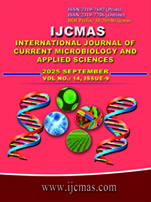


 National Academy of Agricultural Sciences (NAAS)
National Academy of Agricultural Sciences (NAAS)

|
PRINT ISSN : 2319-7692
Online ISSN : 2319-7706 Issues : 12 per year Publisher : Excellent Publishers Email : editorijcmas@gmail.com / submit@ijcmas.com Editor-in-chief: Dr.M.Prakash Index Copernicus ICV 2018: 95.39 NAAS RATING 2020: 5.38 |
Urinary tract infections (UTIs) are a major public health concern, with Escherichia coli being the predominant uropathogen. The increasing emergence of multidrug-resistant (MDR) strains, particularly those producing extended-spectrum β-lactamases (ESBLs), complicates treatment strategies. This study aimed to detect and characterize ESBL genotypes among MDR uropathogenic E. coli isolated from clinical urine samples. Phenotypic confirmation of ESBL production was performed using standard disc diffusion methods, and molecular analysis was conducted to identify the presence of key ESBL genes, including blaTEM, blaSHV, and blaCTX-M. A high prevalence of ESBL producers was observed, with blaCTX-M being the most common genotype detected. The isolates exhibited resistance to multiple antibiotic classes, while showing susceptibility to carbapenems. The findings highlight the urgent need for molecular surveillance and antibiotic stewardship to curb the spread of ESBL-producing uropathogens in clinical settings.
Acharya A., Gautam R., Subedee L. Uropathogens and their antimicrobial susceptibility pattern in Bharatpur, Nepal. Nepal Medical College Journal: NMCJ.: 13(1):30–33(2011)
Baral P., Neupane S., Marasini B. P., Ghimire K. R., Lekhak B., Shrestha B. High prevalence of multidrug resistance in bacterial uropathogens from Kathmandu, Nepal. BMC Research Notes. ; 5P: 5-38. (2012)
Chen Y.-H., Ko W.-C., Hsueh P.-R. Emerging resistance problems and future perspectives in pharmacotherapy for complicated urinary tract infections. Expert Opinion on Pharmacotherapy :14(5):587–596 :(2013)
Chin B. S., Kim M. S., Han S. H., et al. Risk factors of all-cause in-hospital mortality among Korean elderly bacteremic urinary tract infection (UTI) patients. Archives of Gerontology and Geriatrics.;52(1):e50–e55 (2011)
Flores-Mireles A. L., Walker J. N., Caparon M., Hultgren S. J. Urinary tract infections: epidemiology, mechanisms of infection and treatment options. Nature Reviews Microbiology. ;13(5):269–284 (2015)
Foxman B. Urinary tract infection syndromes. Infectious Disease Clinics of North America.; 28(1):13 (2014)
Hicklinsg D. R., Nitti V. W. Management of recurrent urinary tract infections in healthy adult women. Reviews in Urology. ; 15(2):41–48 (2013).
Isenberg H. D. Clinical Microbiology Procedure Handbook. 2nd. Washington, DC, USA: American Society for Microbiology; (2004)
Kattel H. P., Acharya J., Mishra S. K., Rijal B. P., Pokhrel B. M. Bacteriology of urinary tract infection among patients attending Tribhuvan University teaching hospital Kathmandu
Nepal. Journal of Nepal Association for Medical Laboratory Sciences P. 9(1):25–29 (2008).
Kumari N., Ghimire G., Magar J. K., Mohapatra T. M., Rai A. Antibiogram pattern of isolates from UTI cases in Eastern part of Nepal. Nepal Medical College Journal : NMCJ. ;7(2):116–118 (2005)
Lalueza A., Sanz-Trepiana L., Bermejo N., et al. Risk factors for bacteremia in urinary tract infections attended in the emergency department. Internal and Emergency Medicine. ;13(1):41–50 (2018)
Livermore D. M. Current epidemiology and growing resistance of gram-negative pathogens. The Korean Journal of Internal Medicine. 27(2):128–142 (2012)
Magiorakos A.-P., Srinivasan A., Carey R. B., et al. Multidrug-resistant, extensively drug-resistant and pandrug-resistant bacteria: an international expert proposal for interim standard definitions for acquired resistance. Clinical Microbiology and Infection. ;18(3):268–281 (2012)
Maharjan A., Bhetwal A., Shakya S., et al. Ugly bugs in healthy guts! Carriage of multidrug-resistant and ESBL-producing commensal Enterobacteriaceae in the intestine of healthy Nepalese adults. Infection and Drug Resistance. 11:547–554 (2018)
Najar M. S., Saldanha C. L., Banday K. A. Approach to urinary tract infections. Indian Journal of Nephrology.19(4):129–139 (2009)
Nickel J. C. Urinary tract infections and resistant bacteria: highlights of a symposium at the combined meeting of the 25th international congress of chemotherapy (ICC) and the 17th European congress of clinical microbiology and infectious diseases (ECCMID), march 31-april 3, 2007, Munich, Germany. Nature Reviews Urology. ;9(2):78–80 (2007)
Orenstein R., Wong E. S. Urinary tract infections in adults. American Family Physician. ;59(5):1225–1234 (1999)
Parajuli N. P., Maharjan P., Joshi G., Khanal P. R. Emerging perils of extended spectrum β-lactamase producing enterobacteriaceae clinical isolates in a teaching hospital of Nepal. BioMed Research International. :p. 7 (2016).
Paterson D. L., Bonomo R. A. Extended-spectrum-lactamases: a clinical update. Clinical Microbiology Reviews. ;18(4):657–686 ( 2005 )
Picozzi S. M., Paola G., Costa E., et al. Extended-spectrum beta-lactamase-positive Essherichia coli causing complicated upper urinary tract infection: urologist should act in time. Urology Annals 6(2):107–112 (2014)
Pitout J. D., Laupland K. B. Extended-spectrum β-lactamase-producing Enterobacteriaceae: an emerging public-health concern. The Lancet Infectious Diseases. ;8(3):159–166 (2008)
Raza S., Pandey S., Bhatt C. P. Microbiological analysis of isolates in Kathmandu medical college teaching hospital, Kathmandu, Nepal. Kathmandu University Medical Journal (KUMJ) 9(4):295–297 (2012)
Shakya R., Amatya R., Karki B. M., Mandal P. K., Shrestha K. K. Spectrum of bacterial pathogens and their antibiogram from cases of urinary tract infection among renal disorder patients. Nepal Medical College Journal : NMCJ.;16(1):75–79 (2014)
Wayne P. A. Performance Standards for Antimicrobial Disk Susceptibility Tests. 12th. Wayne, PA, USA: Clinical and Laboratory Standards Institute; (2015)
Yadav K. K., Adhikari N., Khadka R., Pant A. D., Shah B. Multidrug resistant Enterobacteriaceae and extended spectrum beta-lactamase producing Escherichia coli: a cross-sectional study in National Kidney Center, Nepal. Antimicrobial Resistance and Infection Control. 4(1):p. 42 (2015) |
 |
 |
 |
 |